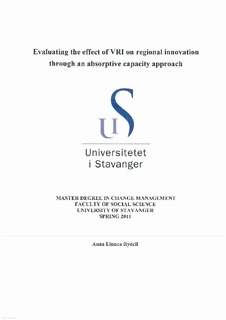| dc.contributor.author | Rydell, Anna Linnea | |
| dc.date.accessioned | 2011-09-16T13:39:51Z | |
| dc.date.available | 2011-09-16T13:39:51Z | |
| dc.date.issued | 2011 | |
| dc.identifier.uri | http://hdl.handle.net/11250/184624 | |
| dc.description | Master's thesis in Change management | en_US |
| dc.description.abstract | The purpose of this to study was to evaluate the effect of the VRI (Virkemidler for regional innovasjon) project on regional innovation. This effect was evaluated through an absorptive capacity approach.
Explained in basics, the concept of absorptive capacity can be understood as an organization’s ability to find, absorb and make use external knowledge to enhance its competitiveness by creating even better products, services and solutions. It is therefore closely knit to innovative output and the ability to be in the forefront. This study therefore aimed at finding out how VRI’s various enablers affected the participating organizations’ absorptive capacity and therefore also, their innovative capability.
The operalization of the concept make it possible to further explain how four different dimensions contribute to the overall absorptive capacity (and therefore also its two components potential absorptive capacity and realized absorptive capacity). The dimensions are described to have a variety of internal and external factors that affect them and in turn, the overall absorptive capacity. It is therefore possible to indirectly evaluate the level of absorptive capacity in an organization by mapping out the presence of these factors.
The chosen method was qualitative oriented using semi structured interviews. The interview questions were designed to find out if and how the VRI enablers affected the above mentioned influencing factors. Interviews were conducted with VRI-participant companies in each of the VRI categorized sectors of energy and maritime. As a reference group, interviews were also conducted with non VRI-participants in each of the sectors.
The thesis concludes that VRI mainly influences the level of absorptive capacity in the participating organizations by enabling them to better identify relevant, external knowledge. This is done by initiating R&D collaborating with knowledge institutions, various attempts to increase the organizations’ prior knowledge base and by offering expertise help to identify external knowledge.
This is not enough, however, for the organizations to achieve a long lasting absorptive capacity. Instead it is up to the organization itself to build the routines and practices that affect the ability to also absorb and make use of external knowledge into competitive advantages. This can be done by focusing on the characteristics concerning both the organization itself and its employees. | en_US |
| dc.language.iso | eng | en_US |
| dc.publisher | University of Stavanger, Norway | en_US |
| dc.relation.ispartofseries | Masteroppgave/UIS-SV-IMKS/2011; | |
| dc.subject | endringsledelse | en_US |
| dc.title | Evaluating the effect of VRI on regional innovation through an absorptive capacity approach | en_US |
| dc.type | Master thesis | en_US |
| dc.subject.nsi | VDP::Social science: 200::Economics: 210::Business: 213 | en_US |
